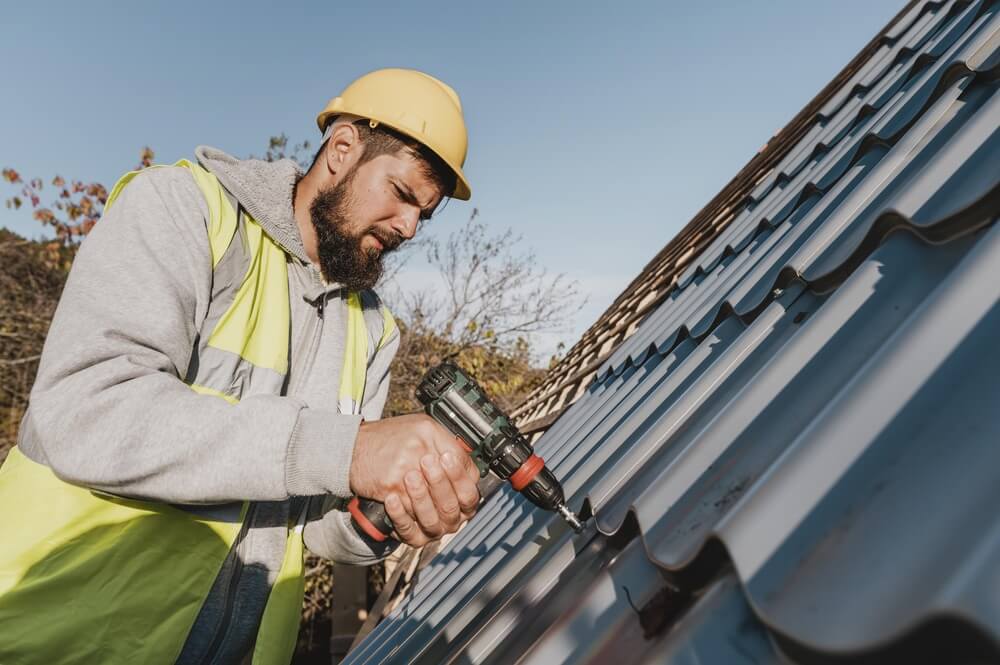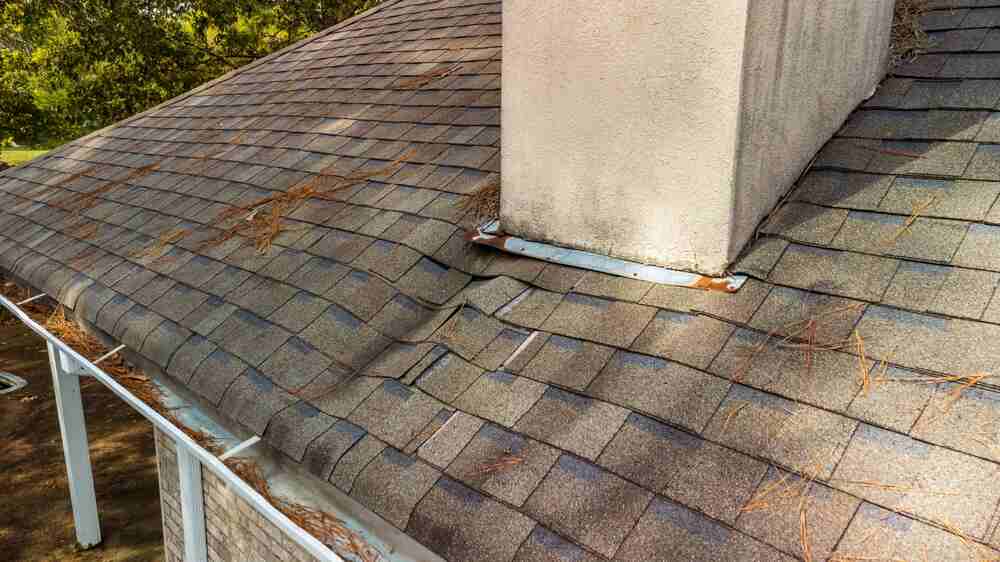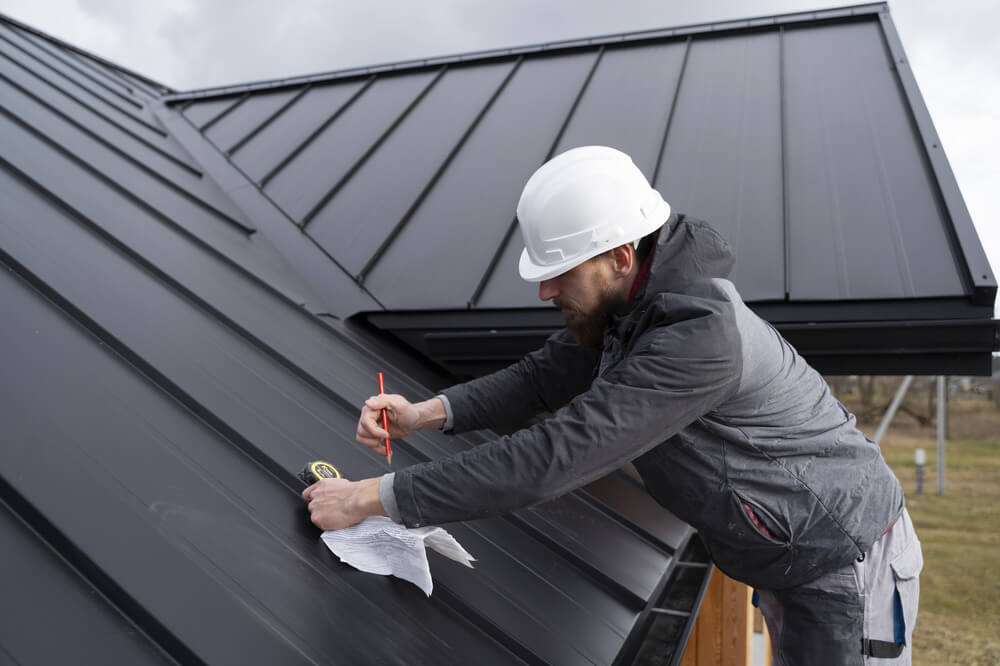
Roof Leak Repair Early Detection to Prevent Potential Damage
A roof protects a home from the elements, but even a small leak can lead to extensive and costly damage. Roof leaks often start as minor issues, but if left undetected, they can compromise structural integrity, encourage mold growth, and increase energy bills. Approximately 5 million new roofs are installed each year in the United States, indicating a significant number of homeowners address roofing issues annually. This highlights the importance of proactive maintenance and early roof leak detection to prevent expensive repairs. Understanding the signs of a leaking roof, identifying high-risk areas, and following best practices can help homeowners take swift action before minor issues escalate.
Here are the essential steps for roof leak repair to safeguard a home from severe water damage.
Table of Contents
Key Takeaways✔ Inspect the roof at least twice a year and after storms to catch early signs of damage before they escalate into major leaks. ✔ Look for damp insulation, mold growth, or water stains in the attic, as they often indicate hidden leaks. ✔ Examine flashing around chimneys, skylights, and vents for cracks or gaps, as these areas are prone to leaks. ✔ Watch for yellow or brown stains, peeling paint, or bubbling wallpaper, which can signal water intrusion. ✔ Ensure that roof valleys and flat sections drain properly, as standing water can weaken the roofing material. ✔ Regularly clean gutters and downspouts to prevent water buildup that can seep under shingles and cause leaks. ✔ Schedule annual professional inspections to detect hidden vulnerabilities and ensure the roof remains in optimal condition. |
Common Signs of a Roof Leak
Early roof leak detection is critical in preventing further structural damage. Recognizing the warning signs of a leaky roof can help homeowners address issues before they escalate. Here are the most common indicators:
1. Water Stains on Ceilings and Walls
Dark or yellowish stains on ceilings and walls are common indicators of a leak. These stains typically form due to water seeping through the roof and into the home’s structure. If left untreated, the moisture can lead to rot and mold growth.
2. Dripping or Pooling Water Indoors
Any visible water leaks inside the home should be addressed immediately. A slow drip may seem insignificant, but over time, it can lead to severe interior damage, requiring extensive roof leak repair.
3. Musty Odors or Mold Growth
A persistent musty smell often indicates mold, which thrives in damp environments. If mold appears on walls, ceilings, or attic insulation, it could be due to an undetected roof leak. Prompt roof leak inspection can help pinpoint the source before it spreads further.
4. Damaged or Missing Shingles
High winds, storms, and aging can cause shingles to crack, curl, or go missing. When this happens, the roof becomes vulnerable to water infiltration, making professional roof repair services essential.
5. Peeling Paint or Wallpaper
Excess moisture from a roof leak can cause interior paint and wallpaper to bubble or peel. This is a strong indication of underlying water intrusion that requires immediate emergency roof leak repair.
6. Increased Energy Bills
A leaking roof can allow warm or cool air to escape, forcing HVAC systems to work harder. If energy bills are unexpectedly high, it may be worth scheduling a roof leak inspection to check for hidden leaks.

High-Risk Areas for Roof Leaks
Certain areas of the roof are more prone to leaks due to exposure and structural design. Homeowners should prioritize roof leak detection in these vulnerable locations:
1. Around Chimneys and Skylights
The flashing around chimneys and skylights can deteriorate over time, leading to small openings that allow water to seep in. A thorough roof leak inspection can help determine if the flashing needs to be repaired or replaced.
2. Valleys and Roof Slopes
Where two roof slopes meet, water naturally flows downward, increasing the risk of leaks. Poorly installed or damaged valleys often require professional roof repair services to prevent water from penetrating the roofing materials.
3. Gutters and Downspouts
Clogged or damaged gutters prevent proper water drainage, causing water to back up under the shingles. Keeping gutters clean and functioning properly can prevent the need for emergency roof leak repair due to water overflow.
4. Roof Vents and Pipe Boots
Roof vents and pipe boots are necessary for ventilation but can become entry points for water if their seals crack. Routine roof leak detection ensures these areas remain secure and watertight.
5. Attic and Insulation
A damp attic or wet insulation is a strong indication of a roof leak. Homeowners should conduct periodic attic checks to detect leaks early and schedule roof repair services as needed.
Best Practices for Early Leak Detection
Preventing leaks before they cause damage is the best approach. While many leaks start small, they can quickly escalate into costly repairs if left unnoticed. Here are the most effective methods for roof leak detection:

1. Conduct Regular Roof Inspections
Inspecting the roof regularly is one of the most effective ways to catch leaks early. For a thorough assessment, hiring a professional roof leak inspection ensures all potential vulnerabilities are identified and addressed.
- Check twice a year – Inspect the roof in spring and fall to assess wear and tear. Seasonal temperature changes can weaken roofing materials, increasing the risk of leaks.
- Look after storms – Heavy rain, hail, or strong winds can damage shingles or flashing. Even minor damage can worsen over time if not addressed quickly.
- Examine for missing shingles – Cracked, curled, or missing shingles expose the roof to leaks. Shingles act as the first line of defense against water intrusion, so any damage should be fixed immediately.
- Inspect drainage areas – Gutters and downspouts should be clear and directing water properly. Poor drainage can lead to standing water, increasing the likelihood of roof deterioration.
2. Check the Attic for Moisture
Attic inspections can reveal early signs of a roof leak before damage spreads to living areas. If moisture is present, scheduling roof repair services can prevent further structural damage.
- Feel for damp insulation – Wet insulation is ineffective and signals a possible leak. Moist insulation can also contribute to mold growth and reduced energy efficiency.
- Look for mold or mildew – These thrive in moist environments and indicate hidden water intrusion. Mold spores can spread quickly and pose serious health risks if left untreated.
- Inspect wooden beams – Dark stains or soft spots may suggest prolonged moisture exposure. Rotted beams weaken the roof’s structure, potentially leading to costly repairs.
- Check for sunlight – If light filters through the roof, there may be holes that need roof leak repair. Even tiny gaps can allow moisture and pests to enter the home.
3. Inspect Flashing and Sealants
Flashing seals vulnerable areas of the roof, such as chimneys, skylights, and vents. Over time, it can deteriorate, leading to leaks. If flashing damage is found, professional roof repair services can replace or reseal affected areas to prevent water intrusion.
- Check chimney and skylight flashing – Loose or cracked flashing allows water to seep in. Water can accumulate around these areas, leading to persistent leaks and mold growth.
- Inspect vent pipes – Ensure the rubber boots and sealants remain intact. Deteriorating seals around vents can cause slow but steady water damage over time.
- Look at roof valleys – These areas endure heavy water runoff and need to stay well-sealed. Poorly maintained valleys can become weak spots that let water penetrate deep into the roofing layers.
4. Monitor Ceiling and Wall Discoloration
Water stains on ceilings and walls are often the first visible signs of a roof leak. Even small stains should not be ignored, as they can signal a hidden leak requiring immediate roof leak detection.
- Look for yellow or brown stains – Expanding stains may indicate ongoing leaks. Even a small stain can signal a much larger underlying problem.
- Check for peeling paint – Trapped moisture can cause bubbling or warping. Excess moisture behind walls can weaken drywall and lead to costly interior repairs.
- Inspect wallpaper – Soft drywall or shifting wallpaper could mean hidden water damage. If ignored, prolonged exposure to moisture can compromise the integrity of walls and ceilings.
5. Check Roof Valleys and Low-Slope Areas
Some parts of the roof are more prone to leaks due to increased water runoff. Regular maintenance, including clearing debris and checking for structural sagging, helps prevent emergency roof leak repair.
- Inspect roof valleys – Water collects here, making the shingles more prone to wear. If the shingles in valleys become loose, water can quickly penetrate the underlayment and cause leaks.
- Check flat or low-slope areas – Poor drainage can cause standing water and leaks. These areas are especially vulnerable to leaks because water takes longer to evaporate or drain.
- Look for sagging – Structural weakening can lead to water pooling and long-term damage. A sagging roofline is often a sign of prolonged water exposure, requiring urgent repairs.
6. Keep Gutters and Downspouts Clear
Clogged gutters prevent water from flowing away from the roof, increasing the risk of leaks. When gutters overflow, water can back up under shingles, requiring roof repair services to address resulting leaks.
- Clean gutters regularly – Remove leaves and debris in fall and spring. Clogged gutters can cause water to back up under shingles, leading to interior water damage.
- Check for damage – Look for sagging, loose sections, or holes. Damaged gutters can lead to improper drainage, allowing water to accumulate along the roof’s edges.
- Ensure proper drainage – Downspouts should direct water at least 3-5 feet away from the home’s foundation. Improperly directed water can seep into the home’s foundation, causing structural damage over time.
7. Hire a Professional Roof Inspection
While homeowners can conduct basic checks, professionals offer a more in-depth roof leak inspection using advanced tools. Scheduling an annual inspection ensures that small problems are caught before they require costly roof leak repair.
- Use moisture meters – Professionals detect hidden water inside ceilings or walls. This ensures leaks are caught before they become visible, preventing extensive damage.
- Infrared scanning – Identifies leaks based on temperature differences. Thermal imaging helps locate moisture trapped within roofing materials that might otherwise go unnoticed.
- Drone and camera inspections – Safely check hard-to-reach areas for damage. Aerial inspections provide a comprehensive view of the entire roof without risking injury.
Immediate Steps to Take When You Detect a Roof Leak
A roof leak can cause extensive damage if not addressed quickly. Taking immediate action can help minimize structural issues, prevent mold growth, and reduce repair costs. Here are the essential steps homeowners should take as soon as they detect a leak:
1. Contain the Water
Water damage can quickly spread, affecting ceilings, walls, flooring, and personal belongings. To minimize the impact:
- Place buckets or containers under the leak to catch dripping water.
- Use absorbent towels or rags to soak up standing water on floors or furniture.
- Move electronics, rugs, and furniture away from the affected area to prevent further damage.
- Create a drainage hole if needed – If the ceiling is bulging with trapped water, use a screwdriver to carefully puncture the weakest point and allow controlled drainage.
2. Identify the Leak Source
Finding the exact location of the leak is essential for effective roof leak repair. However, water often travels before it becomes visible, making the source tricky to pinpoint. Here’s what homeowners should do:
- Inspect the attic with a flashlight to look for wet spots, damp insulation, or mold growth.
- Trace water stains and discoloration on ceilings and walls to determine where the leak originates.
- Check the roof exterior if it’s safe – Look for missing shingles, damaged flashing, or clogged gutters.
- Use the “water hose test” cautiously – If the leak source isn’t obvious, spraying a small amount of water on the roof while someone observes from inside can help locate the issue.
3. Temporarily Seal the Leak
A temporary seal can prevent further water intrusion until permanent roof repair services are completed. Depending on the severity of the leak:
- Apply roofing tar or caulk over small cracks or openings.
- Use a waterproof tarp – Secure a large, heavy-duty tarp over the damaged section of the roof using nails or bricks to hold it in place.
- Seal around vents or flashing with roofing tape or silicone-based sealant.
- Common DIY roof leak repairs include replacing damaged flashing, clearing ice buildup, unclogging gutters, sealing cracked vent boots, replacing missing or broken shingles, and patching skylight leaks.
4. Remove Excess Moisture
Trapped moisture can lead to mold growth and weaken structural components. To prevent long-term damage:
- Use fans and dehumidifiers to dry the affected area.
- Open windows and improve ventilation to reduce humidity levels.
- Check insulation and drywall – If saturated, they may need to be replaced to prevent deterioration.
- Wipe down walls and furniture to remove any residual dampness.
5. Call a Professional Roofing Contractor
While temporary fixes can help, professional roof repair services are necessary for long-term solutions. A roofing expert will:
- Conduct a thorough roof leak inspection to assess the extent of the damage.
- Replace damaged shingles, flashing, or underlayment to restore the roof’s integrity.
- Address structural concerns if water has compromised beams or supports.
- Ensure proper ventilation and waterproofing to prevent future leaks.
When to Seek Professional Roof Repair
While minor roof issues can sometimes be managed with DIY solutions, certain situations demand immediate professional intervention. Here are the most urgent scenarios that require professional roof leak repair:
1. Widespread Shingle or Flashing Damage
Shingles and flashing serve as the first line of defense against water infiltration. If multiple shingles are missing, cracked, or curling, or if flashing around chimneys, skylights, and vents is deteriorating, professional intervention is necessary.
2. Persistent or Recurring Leaks
If a leak continues to reappear despite temporary repairs, there is likely an underlying issue that needs professional attention. Roof leak detection by an expert can uncover hidden problems that DIY fixes often miss. A professional roof leak inspection can diagnose the root cause and provide a lasting solution rather than a temporary fix.
3. Mold Growth or Structural Weakness
Moisture from a leaking roof creates the perfect conditions for mold, mildew, and wood rot. If left untreated, these problems can severely compromise indoor air quality and the structural integrity of the home.
4. After Severe Storms or Natural Disasters
Storms, hurricanes, hail, and high winds can cause significant roof damage, often in ways that aren’t immediately visible. Even if there are no obvious leaks, roof leak detection after extreme weather is essential to catch hidden vulnerabilities before they lead to serious issues.
Frequently Asked Questions
What are the common causes of roof leaks?
Roof leaks can be caused by missing or damaged shingles, cracked flashing, clogged gutters, or poor roof installation. Age-related wear and tear, along with extreme weather conditions, can also weaken roofing materials over time. Regular roof leak inspection and maintenance help prevent these issues from developing into major leaks.
Can a roof leak cause health problems?
Yes, roof leaks can lead to mold and mildew growth, which may cause respiratory issues, allergies, and other health concerns. Prolonged exposure to damp conditions can worsen asthma and other breathing difficulties. Addressing leaks quickly with roof leak repair helps prevent mold-related health risks.
How long does it take to repair a roof leak?
The time required for roof repair services depends on the severity of the damage and weather conditions. Minor leaks may be fixed in a few hours, while more extensive damage could take several days. A professional roof leak inspection will determine the exact repair timeline.
Does homeowners insurance cover roof leak repairs?
Many homeowners insurance policies cover roof leak repair if the damage results from a covered peril, such as storms, hail, or falling debris. However, damage caused by neglect, normal wear, or lack of maintenance is typically not covered. Reviewing your policy and consulting with your insurance provider can clarify what is eligible for coverage.
What should I do if my roof is leaking during a storm?
First, ensure safety by avoiding wet areas and placing buckets to catch dripping water. Use a tarp or plastic sheeting as a temporary fix to minimize interior damage until emergency roof leak repair can be done. Once the storm passes, contact professional roof repair services to assess and fix the issue promptly.
Get Expert Roof Leak Repair from Roofer of Wappingers Falls LLC Today!
Don’t let a small leak turn into a costly disaster—trust Roofer of Wappingers Falls LLC for reliable roof leak repair in Wappingers Falls, NY. Whether you need a professional roof leak inspection, emergency repairs, or ongoing maintenance, our expert team is ready to help. Residents of Wappingers Falls, NY can count on Roofer of Wappingers Falls LLC for top-quality roof repair services that keep their homes safe and secure.
If you’ve noticed water stains, missing shingles, or signs of a leak, don’t wait! Call Roofer of Wappingers Falls LLC today for fast and efficient roof leak detection in Wappingers Falls, NY. Protect your home with expert roofing solutions from a trusted local contractor—contact them now to schedule your roof leak repair!
